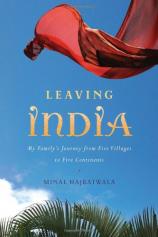Leaving India: My Family’s Journey From Five Villages to Five Continents
Review
Leaving India: My Family’s Journey From Five Villages to Five Continents
Minal Hajratwala set out to write a book about her family in one
year. Seven years and many international miles later, she completed
the task. Piecing together her memories and scattered partial
records including horoscopes, postcards and photographs, and
visiting across the globe with as many of her family members as she
could, Hajratwala became an explorer, mapping both the outer and
inner lives of a huge clan and, with them, her own.
Through the vast scope of this book and its particularities, we
learn that Indians wherever they find themselves generally work
hard. Leaving a harsh life of poverty in Gujerat,
Hajratwala’s grandparents, parents, aunts and uncles did not
shrink from doing menial work that would have been considered
undignified back home. They did not let anything stand in the way
of their determination of furthering the aims of the extended
family, even if it meant never seeing the family again --- husband
leaving wife, children leaving parents. The author herself was an
immigrant by age five, going with her family from New Zealand,
which she thought of as home, to migrate to the U.S. to live among
relatives she had never met before. She has close family in South
Africa, Hong Kong and Canada.
One of the reasons for such far-flung upheavals was the British
Empire and its ceaseless need for laborers to expand new colonial
opportunities. Indian labor was shipped at a per head price to
Fiji, to Africa, to anywhere it was required to keep the Empire
humming. Once there, a laborer became attached to the new
environment and, like Hajratwala’s family, set up not one
shop but many, built homes, developed neighborhoods and left a
permanent mark on large communities. One of her relatives started
as a tailor in Fiji and wound up owning one of the largest
department stores in the South Pacific. Another, orphaned and sent
to Durban when still a child, started with a tiny food stand and
eventually established a centrally located restaurant and became
known as the inventor of a “national” food delicacy.
Hajratwala learned that the restaurant had been used as a meeting
place by Nelson Mandela in his early activist days.
Hajratwala’s grandfather marched with Gandhi during the
famous salt boycott, going to prison for his principles. As she
retells these family legends, she reveals a sweeping historical
panorama, a view of the Indian diaspora rarely seen in so
many facets.
Hajratwala focuses closely on the lives of her ancestors but
more so on the lives of people she has had a chance to visit and
follow personally, such as her cousin Mala and Mala’s husband
Madhukant, a Fijian couple who applied to emigrate to the U.S. by
lottery and won two of the small number of places sought after by
thousands of Asians. Once there, they lived a hand-to-mouth
existence, both holding down as many as three jobs at a time. Both
won employee awards at the fast food joints and parking garages
where they found employment. They even tried motel work, one career
that has been opened up to Asians largely through the machinations
of people from Gujerat. In less than 50 years, a few southern Asian
families have parlayed a willingness to do every task associated
with motel management and a strong family support system into a
remarkable monopoly of motel ownership across America. As Mala
penetrated ever deeper into the American scene, she stopped wearing
saris and willingly donned the scratchy uniforms required by her
jobs at McDonald’s and in a hospital. She considers her life
in the complicated culture of America “freedom”
compared to her youth spent in a traditional setting, under the
thrall of a tyrannical mother-in-law.
The author also learned about freedom in America. From asserting
her independence as a college student by traveling far from her
Michigan home to Stanford University, to dabbling in the heady
vapors of feminism, to the conviction that she is a lesbian, she
made departures from her heritage, even refusing marriage, a shock
to her tradition-minded parents. But each “departure”
was a journey to somewhere else, in that way asserting her inner
bond with the diaspora.
“Every migrant,” Hajratwala writes,
“constructs, or spends her life seeking, a new definition of
home.” She has found her home on what she calls her
“queer planet” --- but she has the comfort that she is
never far from her family and her heritage. As she has followed it,
it follows her, all over the world.
Reviewed by Barbara Bamberger Scott on December 30, 2010
Leaving India: My Family’s Journey From Five Villages to Five Continents
- Publication Date: March 18, 2009
- Genres: History, Nonfiction
- Hardcover: 352 pages
- Publisher: Houghton Mifflin Harcourt
- ISBN-10: 0618251294
- ISBN-13: 9780618251292




